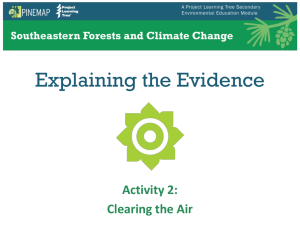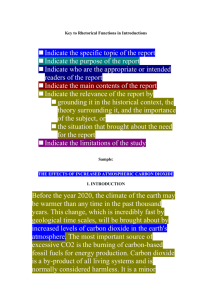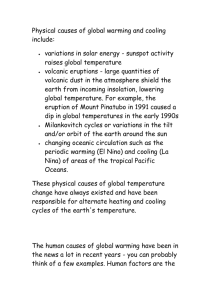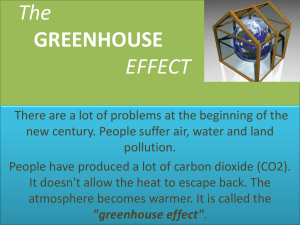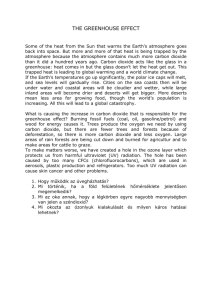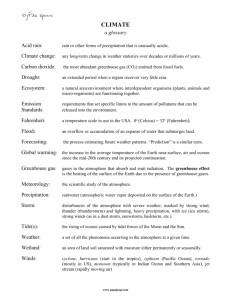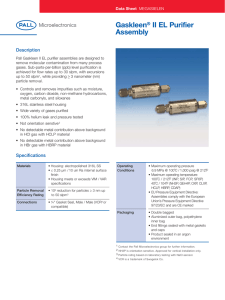Atlas Guide
advertisement
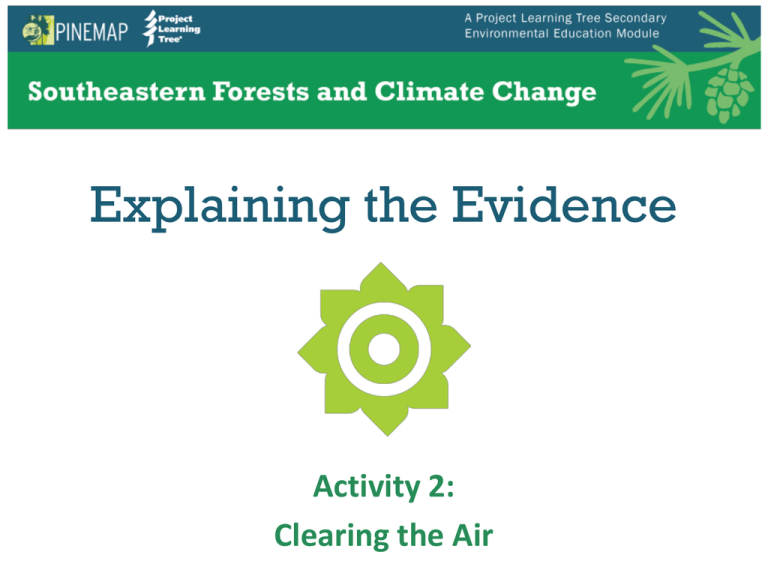
Explaining the Evidence Activity 2: Clearing the Air How Many of You Have Heard That… • Climate change is due to human activities. or… Climate change is due to human and natural causes. • Nearly all climate scientists agree on causes of climate change. or… Most scientists do not agree on causes of climate change. Beliefs and Assumptions • People have beliefs about many things. – Ideas that we think are true – Based on a number of sources such as past experiences, faith, or what someone said – Can change as people learn and have new experiences • Assumptions are underlying ideas behind beliefs. – Connect evidence to conclusions – May or may not be based on fact – Important to distinguish assumptions from beliefs Sample Beliefs and Assumptions about Climate Change Assumption: Carbon dioxide is one of many atmospheric gases, and it makes up a small percent of the total gases in our atmosphere. Therefore, it is logical to believe… Belief: The small amount of carbon dioxide added to the atmosphere by humans cannot cause climate change. Assumption: Carbon dioxide occurs naturally in small amounts, but is very efficient at absorbing heat energy. Therefore, it is logical to believe… Belief: Any amount of carbon dioxide added to the atmosphere by humans can cause climate change. Science • Science is a way of knowing about the natural and material world. –Hypothesis –Data –Evidence –Conclusions Weather vs. Climate • Weather describes the atmospheric conditions at a specific place at a specific point in time. • Climate is determined by long term trends in weather. http://www.youtube.com/watch?v=e0vj-0imOLw Evidence of Climate Change • Will not be the same everywhere – Some places will be wetter, others will be drier – Polar regions will see greater increases in temperature than tropical regions • Includes changes in – Earth’s average temperature – Patterns and amounts of precipitation – Ice and snow cover – Sea level – Extreme weather events 1. Temperature (1880-2010) 1. Temperature (1000-2000) Variations of the Earth’s surface temperature for the past 1,000 years 2. Precipitation Observed Precipitation Changes: 1901-2007 Statistically Significant Trends in Precipitation Anomaly (inches/decade): 1895-2011 Southeast Winter Spring Summer Fall Annual ----- ----- -0.10 +0.27 ----- 3. Sea Ice 4. Sea Level 5. Catastrophes, Including Extreme Weather Events Climate is Affected by Several Factors Historical Climate Change • • • • • • Solar radiation Ocean composition Greenhouse effect Albedo effect Continental land arrangement Volcanic eruptions Recent Climate Change • • • • • • • • Solar radiation Ocean composition Greenhouse effect Albedo effect Continental land arrangement Volcanic eruptions Fossil fuel combustion Land-use change from human activities Solar Radiation Radiative Forcing Land-Use Change In the Southeast U.S., land use changes from bare soil in cotton and other row crops to forests (currently 70 percent of the region) may have contributed to the negative trend in temperature over the past 100 years. We Have Also Altered the Atmosphere Greenhouse Gas Pre-1750 Tropospheric Concentration Recent Tropospheric Concentration Change in Tropospheric Concentration Carbon dioxide (CO2) 280 ppm 393 ppm 40% Methane (CH4) 700 ppb 1874 ppb 168% Nitrous oxide (N2O) 270 ppb 324 ppb 20% Chlorofluorocarbons (CFCs) 0 21-529 ppb NA Ozone (O3) ppm = parts per million ppb = parts per billion (different for each CFC) 25 ppb 34 ppb 36% Atmospheric Greenhouse Gases a Focus on CO2 • CO2 has changed the most. • CO2 stays in the atmosphere a long time. • The US emits more CO2 than other greenhouse gases. • We can do something about it. 800,000 Year Record of CO2 Concentration Carbon is Everywhere Global and Continental Temperature Change Natural forces alone do not explain the changes in temperature. What Does All This Mean? • 97% of climate scientists combine this and other evidence to draw these conclusions: – Earth’s climate is currently changing due to global warming. – Changes are not the same at all locations on Earth. – Future changes may be more rapid than historical changes. – Human activities are responsible for most of the climate change being observed. Agreement Among Climate Scientists What Will Happen in the Future? Forest Habitat Changing Future Model – High Emissions Current Modeled Forest Future Model – Low Emissions Legend White/Red/Jack Pine Spruce/Fire Longleaf/Slash Pine Loblolly/Shortleaf Pine Oak/Pine Oak/Hickory Oak/Gum/Cypress Elm/Ash/Cottonwood Maple/Beech/Birch Aspen/Birch No Data A Movable Carbon Map www.carbonmap.org What Could Happen in the Southeast? • Southeast’s climate is largely influenced by El Niño and La Niña • Sea level rise – Coastal erosion • Warmer temperatures – More invasive exotic organisms – Greater risk of wildfire • Increased yield in some crops if water is plentiful • Less rain in the growing season in some places – Harm to crops, or changes in planting times It’s a Challenge • • • • • A very complex system Regional variation Changes are hard to see No firm predictions; models have limitations Not just about the science - Political, Economic The U.S. Public Has Many Beliefs about Climate Change But Why disagreement? • People see and remember information that matches what they know – So it is hard to change someone’s mind • People have partial information and leap to conclusions – And then when presented with complete information, it doesn’t match • People listen to influential leaders – Rather than figuring it out for themselves Solutions to Climate Change • Lots of options; no single solution – Adaptation – Mitigation • Policies and actions implemented by – Governments: international, national, state, local – Industry and business – Individuals – all of us!
